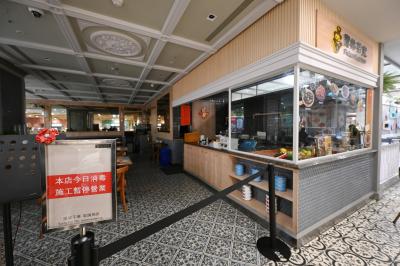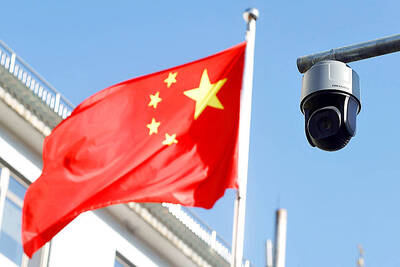Located in the heart of Taipei’s historic Dadaocheng (大稻埕) area, the Xia Hai City God Temple (霞海城隍廟) has become a must-see attraction thanks to the manager’s decades-long effort to preserve the temple and revitalize the community.
“When I travel abroad to promote tourism to the temple, I always invite people running businesses in the neighborhood to come along,” said 69-year-old Tracy Chen (陳文文), who has served as temple manager for 26 years.
When hosting travel shows abroad to introduce the temple to potential tourists, Chen takes the opportunity to showcase local delicacies, such as pastries, cakes and tea, she said.

Photo: CNA
Some people believe that the temple’s city god helps their businesses flourish, she said, adding: “However, it is ancestral workmanship that has left a rich cultural milieu and makes the temple an attractive destination.”
Following the sudden death of one of her brothers in 1994, Chen shouldered the temple’s managerial duties, making her the sixth generation to head the family-owned place of worship, which was built in 1859 on Dihua Street (迪化街), in what is now Datong District (大同).
The Ministry of the Interior in 1985 listed the temple as a historical monument. It is touted as one of Taipei’s “big three” temples, along with Baoan Temple (保安宮) in the same district and Wanhua District’s (萬華) Longshan Temple (龍山寺).
Although it is small, covering just 152m2, the temple has the highest density of statues in Taiwan, housing more than 600 deities in addition to the city god, his wife and the renowned matchmaking god, Chen said.
One of Chen’s many initiatives to revamp the Dadaocheng area, which saw its heyday as a major shipping port on the banks of the Tamsui River in the mid-19th century, is a twice-per-month group tour designed for people to explore the area’s history and culture.
Since the “Wandering Dadaocheng” project was launched in June 1997, more than 500 tours have been conducted, with experts in architecture and historical relics leading visitors on strolls through the alleyways steeped in history to understand Taipei’s past and experience the neighborhood’s mix of old and new.
The temple’s management was surprised that members of the public — and not just historians — have welcomed the tours so warmly.
The enthusiasm that the tours have generated for area preservation has helped keep the community’s collective memory alive, Chen said, adding that it has been a major push behind public and private refurbishment projects.
More than 70 community buildings have been awarded listed-building status by the Taipei City Government, she added.
“Thanks to decades of effort, we are proud to say that the Dadaocheng community is recognized as the nation’s best-preserved historical neighborhood,” she said.
International tourists visiting Taipei in 2017 ranked the Dadaocheng area as the third most-loved attraction, a survey released in October last year by the city’s Department of Information and Tourism showed.
The historic district is famous for century-old buildings of various styles that have been repurposed into shops selling products of time-honored workmanship, including tea, Chinese herbal medicine, dried goods and snacks, textiles and calligraphy brushes, alongside trendy venues that house cultural and creative industry start-ups.
“I was really touched when I recently came across a travel guide book in a Japanese hotel that juxtaposed photographs of Xia Hai City God Temple and Taipei 101,” Chen said. “That made me feel our efforts had not been in vain and that we must keep them up.”

POLAM KOPITIAM CASE: Of the two people still in hospital, one has undergone a liver transplant and is improving, while the other is being evaluated for a liver transplant A fourth person has died from bongkrek acid poisoning linked to the Polam Kopitiam (寶林茶室) restaurant in Taipei’s Far Eastern Sogo Xinyi A13 Department Store, the Ministry of Health and Welfare said yesterday, as two other people remain seriously ill in hospital. The first death was reported on March 24. The man had been 39 years old and had eaten at the restaurant on March 22. As more cases of suspected food poisoning involving people who had eaten at the restaurant were reported by hospitals on March 26, the ministry and the Taipei Department of Health launched an investigation. The Food and

The long-awaited Taichung aquarium is expected to open next year after more than a decade of development. The building in Cingshui District (清水) is to feature a large ocean aquarium on the first floor, coral display area on the second floor, a jellyfish tank and Dajia River (大甲溪) basin display on the third, a river estuary display and restaurant on the fourth, and a cafe and garden on the fifth. As it is near Wuci Fishing Port (梧棲漁港), many are expecting the opening of the aquarium to bring more tourism to the harbor. Speaking at the city council on Monday, Taichung City Councilor

A fourth person has died in a food poisoning outbreak linked to the Xinyi (信義) branch of Malaysian restaurant chain Polam Kopitiam (寶林茶室) in Taipei, Deputy Minister of Health and Welfare Victor Wang (王必勝) said on Monday. It was the second fatality in three days, after another was announced on Saturday. The 40-year-old woman experienced multiple organ failure in the early hours on Monday, and the family decided not to undergo emergency resuscitation, Wang said. She initially showed signs of improvement after seeking medical treatment for nausea, vomiting and diarrhea, but her condition worsened due to an infection, he said. Two others who

Taiwanese should be mindful when visiting China, as Beijing in July is likely to tighten the implementation of policies on national security following the introduction of two regulations, a researcher said on Saturday. China on Friday unveiled the regulations governing the law enforcement and judicial activities of national security agencies. They would help crack down on “illegal” and “criminal” activities that Beijing considers to be endangering national security, according to reports by China’s state media. The definition of what constitutes a national security threat in China is vague, Taiwan Thinktank researcher Wu Se-chih (吳瑟致) said. The two procedural regulations are to provide Chinese